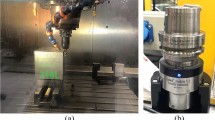Abstract
To obtain a superior machined surface quality, predicting cutting force is important for planning and optimizing cutting process before actual machining. This paper established a novel analytical cutting force model for end milling of curved surfaces. Taking the variation of cutter geometry into account, cutting force coefficients were characterized by physical parameters, e.g., the normal friction angle, the normal shear angle, the chip flow angle, and the shear stress. Based on an oblique cutting model, a mathematical relationship of the physical parameters was obtained by the minimum energy principle. A Newton iterative algorithm was utilized to solve the established non-linear equations for calibrating the cutting force coefficients. Taken the variable radial depths of cut into account, a vector method was derived to calculate the equivalent feed rates and the entry/exit angles. After calibrating the cutting force coefficients with performing straight milling tests, two typical curved surfaces were investigated. The one was a circular curved surface with constant radial depth of cut, while the other was a Bezier curved surface with variable radial depth of cut. The predicted cutting forces were compared with experimental results, and a good correlation was obtained.
Similar content being viewed by others
References
Altintas Y, Kersting P, Biermann D, Budak E, Denkena B, Lazoglu I (2014) Virtual process systems for part machining operations. CIRP Ann Manuf Technol 63(2):585–605
Held M (1991) On the computational geometry of pocket machining (Vol. 500). Springer Science & Business Media, Berlin
Kiswanto G, Hendriko H, Duc E (2014) An analytical method for obtaining cutter workpiece engagement during a semi-finish in five-axis milling. Comput Aided Des 55:81–93
Zhang L, Zheng L (2004) Prediction of cutting forces in milling of circular corner profiles. Int J Mach Tools Manuf 44(2):225–235
Banerjee A, Feng HY, Bordatchev EV (2012) Geometry of chip formation in circular end milling. Int J Adv Manuf Technol 59(1-4):21–35
Wu BH, Yan X, Luo M, Gao G (2013) Cutting force prediction for circular end milling process. Chin J Aeronaut 26(4):1057–1063
Han X, Tang LM (2015) Precise prediction of forces in milling circular corners. Int J Mach Tools Manuf 88:184–193
Rao VS, Rao PVM (2005) Modelling of tooth trajectory and process geometry in peripheral milling of curved surfaces. Int J Mach Tools Manuf 45(6):617–630
Rao VS, Rao PVM (2006) Effect of workpiece curvature on cutting forces and surface error in peripheral milling. Proc Inst Mech Eng B J Eng Manuf 220(9):1399–1407
Lotfi B, Zhong ZW, Khoo LP (2009) Prediction of cutting forces along Pythagorean-hodograph curves. Int J Adv Manuf Technol 43(9-10):872–882
Desai KA, Agarwal PK, Rao PVM (2009) Process geometry modelling with cutter runout for milling of curved surfaces. Int J Mach Tools Manuf 49(12):1015–1028
Wei ZC, Wang MJ, Ma RG, Wang L (2010) Modelling of process geometry in peripheral milling of curved surfaces. J Mater Process Technol 210(5):799–806
Sun Y, Guo Q (2011) Numerical simulation and prediction of cutting forces in five-axis milling processes with cutter run-out. Int J Mach Tools Manuf 51(10):806–815
Yang Y, Zhang WH, Wan M (2011) Effect of cutter runout on process geometry and forces in peripheral milling of curved surfaces with variable curvature. Int J Mach Tools Manuf 51(5):420–427
Qi H, Tian Y, Zhang D (2013) Machining forces prediction for peripheral milling of low-rigidity component with curved geometry. Int J Adv Manuf Technol 64(9-12):1599–1610
Hao HY, Wang BS, Tang WC (2015) Prediction of instantaneous milling force taking runout into account in peripheral milling of curved surface. Int J Adv Manuf Technol 79(1-4):49–56
Patel K, Bolaños GS, Bassi R, Bedi S (2011) Optimal tool shape selection based on surface geometry for three-axis CNC machining. Int J Adv Manuf Technol 57(5-8):655–670
Budak E, Altintas Y, Armarego EJA (1996) Prediction of milling force coefficients from orthogonal cutting data. J Manuf Sci Eng 118(2):216–224
Engin S, Altintas Y (2001) Mechanics and dynamics of general milling cutters. Part ii: inserted cutters. Int J Mach Tools Manuf 41(15):2213–2231
Kaymakci M, Kilic ZM, Altintas Y (2012) Unified cutting force model for turning, boring, drilling and milling operations. Int J Mach Tools Manuf 54:34–45
Altintas Y (2012) Manufacturing automation: metal cutting mechanics, machine tool vibrations, and CNC design. Cambridge University Press, New York
Armarego E (1994) Material removal processes: an intermediate course. The University of Melbourne
Shamoto E, Altintas Y (1999) Prediction of shear angle in oblique cutting with maximum shear stress and minimum energy principles. J Manuf Sci Eng 121(3):399–407
Dang JW, Zhang WH, Yang Y, Wan M (2010) Cutting force modeling for flat end milling including bottom edge cutting effect. Int J Mach Tools Manuf 50(11):986–997
Stabler GV (1964) The chip flow law and its consequences. Adv Mach Tool Des Res 5:243–251
Desai KA, Rao PVM (2008) Effect of direction of parameterization on cutting forces and surface error in machining curved geometries. Int J Mach Tools Manuf 48(2):249–259
Author information
Authors and Affiliations
Corresponding author
Rights and permissions
About this article
Cite this article
Luo, ZW., Zhao, WX., Jiao, L. et al. Cutting force prediction in end milling of curved surfaces based on oblique cutting model. Int J Adv Manuf Technol 89, 1025–1038 (2017). https://doi.org/10.1007/s00170-016-9101-7
Received:
Accepted:
Published:
Issue Date:
DOI: https://doi.org/10.1007/s00170-016-9101-7




